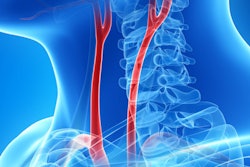
Transcranial Doppler ultrasound can be used to identify those asymptomatic carotid artery stenosis patients who are at greater risk for stroke and would therefore be most likely to benefit from revascularization procedures, according to research published online September 16 in Radiology.
A team led by Ankur Pandya, PhD, of Weill Cornell Medical College found that assessing cerebrovascular reserve (CVR) with transcranial Doppler ultrasound is a cost-effective approach for determining the best way to treat asymptomatic carotid stenosis.
A highly prevalent condition, asymptomatic carotid stenosis can lead to ischemic stroke, which is a leading cause of death and contributor to U.S. healthcare costs. Although revascularization procedures are often performed on patients with asymptomatic carotid stenosis, experts have questioned whether the stroke prevention benefits outweigh the risks and costs of revascularization in these patients, Pandya said.
 Ankur Pandya, PhD, of Weill Cornell Medical College.
Ankur Pandya, PhD, of Weill Cornell Medical College."Imaging-based stroke risk assessment has traditionally focused on the degree of artery narrowing, but there has been growing interest in using CVR assessment to stratify these patients into those who are more likely to have a stroke and, thus, are better candidates for revascularization, and those who would be better off with less-invasive management strategies, such as medical therapy," he told AuntMinnie.com.
A simulation model
As a result, the researchers developed a computer simulation model to evaluate whether a treatment decision rule based on CVR assessment could be used to efficiently select the right patients for revascularization, Pandya said.
Using the model, the researchers projected the hypothetical lifetime health benefits, total healthcare costs, and incremental cost-effectiveness for three strategies in managing asymptomatic patients with carotid stenosis of 70% to 89% carotid luminal narrowing at presentation:
- Immediate revascularization with carotid endarterectomy and ongoing medical therapy with antiplatelet, statin, and antihypertensive agents plus lifestyle modification
- Medical therapy-based treatment with revascularization only for patients who progressed
- A treatment decision rule based on CVR assessed via transcranial Doppler ultrasound: patients found to have CVR impairment undergo immediate revascularization while all others receive medical therapy
Lifetime quality-adjusted years, which estimate both the length and quality of life, were projected for each strategy using the decision analytic model. The researchers estimated the risks of clinical events as well as costs and quality-of-life values using published sources. Because the analysis was conducted from a healthcare system perspective, health and cost outcomes were discounted at 3% (Radiology, September 16, 2014).
| Costs and quality of life for 3 strategies | ||
| Strategy | Total costs | Quality-of-life years |
| Medical therapy-based strategy | $14,597 | 9.848 |
| CVR-based decision rule | $16,583 | 9.934 |
| Immediate revascularization | $20,950 | 9.940 |
The best value for the money
Compared with the medical therapy-based strategy, the CVR-based model had an incremental cost-effectiveness ratio -- calculated using projected costs and quality-of-life years -- of $23,000 per quality-of-life year. The immediate revascularization approach, on the other hand, had an incremental cost-effectiveness ratio of $760,000 per quality-of-life year versus the CVR-based strategy.
While the medical therapy-based strategy had the lowest lifetime costs and the fewest revascularizations, it also produced the lowest life expectancy and lifetime quality-adjusted years, the researchers found. The immediate revascularization strategy generated by far the highest costs and offered only incremental health benefits when compared with the CVR-based approach, which would lead to about half the patients receiving revascularization.
"We found that the CVR-based strategy represented the best value for the money compared to immediate revascularizations or medical therapy-based treatment for all patients," Pandya said.
He noted, though, that combinations of certain variables did lead to the immediate revascularization or medical therapy-based strategies being optimal.
"The optimal decision on performance of revascularization procedures in asymptomatic patients with carotid stenosis depends on baseline risk of stroke and the likelihood of procedure complications, factors that can vary according to patient, provider, and institution," Pandya said.
Nonetheless, the results suggest that a decision rule based on CVR assessment is cost-effective compared with medical therapy or immediate revascularization strategies, the authors concluded.
"Authors of future studies should seek greater accuracy in determining the cost of revascularization and develop methods that would allow more individualized decision-making on the basis of patient stroke risk factors and predicted procedure complication risks," they wrote.
The researchers are now using their simulation model "to explore whether other imaging tests, like MRI, could be efficiently employed to look at the composition and stability of plaque, which may give greater insight into those plaques most likely to rupture and cause symptoms," Pandya said.




















